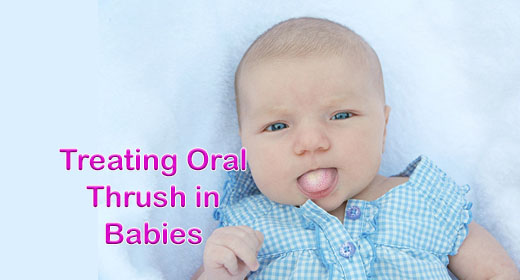Thrush is an oral yeast infection that develops in your child’s mouth. It causes little white or yellowish bumps to form on the inner cheeks, tongue, gums, roof of the mouth and sometimes in their diaper area. Thrush bumps usually go away with treatment.
Thrush is the most common oral fungal infection suffered by infants and children. Thrush is a type of yeast called Candida albicans and while the infection is typically mild and rarely causes serious problems, it is very uncomfortable for your little one.
What Causes Thrush in Babies?
Researchers aren’t sure why, but it’s likely because a newborn has a weaker immune system and can’t yet fight infections well.
That would explain why oral thrush often follows a course of antibiotics. Antibiotics reduce the levels of healthy bacteria in our bodies, and this means fungi have an easier time growing. Oral thrush can also occur after the use of steroid medicines.
Did you have a vaginal yeast infection when you were expecting? If so, your baby could have picked up Candida during your pregnancy, delivery or from breastfeeding.
Symptoms of Thrush in Babies
Look in your baby’s mouth. Do you see any white patches or sores on their tongue, gums, and/or the inside of their mouth? Other thrush symptoms:
- Slight bleeding if the bumps are scraped
- Soreness or burning in their mouth
- Dry, cracked skin at the corners of their mouth
- Oral thrush in babies may also cause difficulty feeding and irritability or fussiness
Now check baby’s diaper area. Do they have a stubborn rash with red dots? This could be thrush.
Can Breastfeeding Mothers Get Thrush?
Thrush infection can be passed between mom’s nipples and baby’s mouth during breastfeeding. How can you tell if you have thrush on your nipples:
- Are your nipples burning and sore?
- Is the skin itchy and flaky?
- Do you feel sharp shooting pains in your breasts during or after feeding?
If you suspect your baby might have oral thrush, have your doctor take a look. If you’re breastfeeding, both of you will need antifungal treatments.
Treatment for Thrush in Babies
For oral thrush, your doctor may prescribe antifungal medication (drops or a gel) containing nystatin, which must be spread on the tongue and inside the mouth a few times a day for 10 days. The easiest way to do this is to use a sponge applicator to paint on the solution.
If thrush is affecting your baby’s diaper area or scalp, you may be able to use over-the-counter antifungals. Again, your doctor will make a recommendation.
Preventing Thrush in Babies
Candida is very contagious. That’s because it’s a dimorphic fungus, meaning that it can switch between being a yeast or a mold depending on the temperature.
Prevention tips to help your baby avoid thrush:
- Take the time to wash your baby’s hands, toys, and pacifiers.
- Launder towels, clothing, and bras that may have come into contact with Candida. The best practice is to use a hot wash cycle.
When breastfeeding be sure to:
- Keep expressed/pumped milk refrigerated until just before use to prevent the growth of yeast.
- Sterilizing your breast pump and the
- Make sure your breasts are dry after every feeding.
- Avoid using disposable nursing pads with a plastic backing, and remember to change your nursing pads when they get wet.
Talk to your doctor about an effective probiotic.
Sources:






